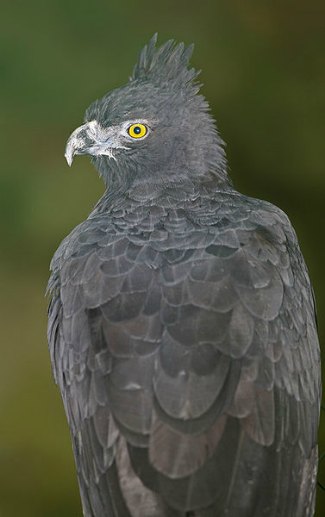Black-and-Chestnut Eagle - Spizaetus isidori
By www.birdphotos.com (Tom Friedel), CC-BY-3.0, via Wikimedia Commons
Family: Accipitridae
Genus: Spizaetus
Species: S. isidori
Black-and-Chestnut Eagles are medium-sized raptors that occur in montane forest across northeastern South America.
Physical Description:
Black-and-Chestnut Eagles are true to their name, with a black body and a chestnut breast, belly, and legs. The tail is gray with a black trailing edge and white streaks. The primary feathers are gray, the secondaries are black, and both are barred. The eyes are yellow and their pointed crest can be 8-10 cm long.
Juveniles have gray-white head and underparts, lighter in color than an adult, with a black crest and streaking on breast and flanks. They reach full adult plumage after four years.
Their call is a sharp, high-pitched whistle. Listen to a Black-and-Chestnut Eagle.
Size:
Length: 60-80 cm
Wingspan: 180 cm
Habitat and Distribution:
They live in dense, undisturbed montane forest along mountain slopes. They have been found in logged areas of forest, but they are thought to occupy them only because of loss of their usual habitat. They live in a range of 0-3,500 meters above sea level, though they are most commonly found from 1,500-2,800 m.
They live along the coastal regions of northwest Venezuela and northeast Colombia, and on the subtropical slopes of the Andes through Ecuador, Peru, Bolivia, and Argentina, over 469,000 km². The population is thought to be between 1,000-2,499 individuals; there are approximately several hundred eagles in Venezuela, 200 in Ecuador, a few hundred in Colombia, a small population in Argentina, and unknown numbers in Peru and Bolivia.
Diet and Hunting:
Black-and-Chestnut Eagles eat a range of mammals from squirrels to monkeys, along with birds such as guans and chickens.
Reproduction:
The breeding season is assumed to be from February-March. The nest is built out of sticks and placed in a high location in a tree, and a single white, brown-spotted egg is laid. The length of the incubation period is unknown. Fledging takes 110-130 days.
Conservation:
Due to a small, declining population and destruction of forest habitat, the Black-and-Chestnut Eagle was uplisted from Near Threatened to Vulnerable by BirdLife International.
Taxonomy:
Spizaetus isidori was formerly considered to be Oroaetus isidori but was merged, also known as "lumped", with the genus Spizaetus.
Other Names:
Isidor’s Eagle, Orel andský (Czech), Andesørn (Danish), Andeskuifarend (Dutch), Koidukotkas (Estonian), Rotkokotka (Finnish), Aigle d'Isidore (French), Isidoradler (German), Spizaeto nero e castano (Italian), Akakurokumataka (Japanese), Andesørn (Norwegian), Andowik (Polish), Aguila Castaña, Aguila de Copete, Aguila Poma (Spanish), Isidors örn (Swedish).
Other Multimedia:
None available.
References:
http://avibase.bsc-eoc.org/species.jsp?avibaseid=D31EE7190803FB0F
BirdLife International (2012) Species factsheet: Spizaetus isidori. Downloaded from http://www.birdlife.org on
07/01/2012.
Global Raptor Information Network. 2012. Species account: Black-and-chestnut Eagle Spizaetus isidori. Downloaded from
http://www.globalraptors.org on 28 May. 2012
BirdLife International 2010. Spizaetus isidori. In: IUCN 2011. IUCN Red List of Threatened Species. Version 2011.2.
www.iucnredlist.org. Downloaded on 28 May 2012.
2010. Black-and-chestnut Eagle (Spizaetus isidori), Neotropical Birds Online (T. S. Schulenberg, Editor). Ithaca: Cornell Lab of Ornithology; retrieved from
Neotropical Birds Online:
http://neotropical.birds.cornell.edu/portal/species/overview?p_p_spp=22334
http://www.planetofbirds.com/accipitriformes-accipitridae-black-and-chestnut-eagle-spizaetus-isidori
Ferguson-Lees, James, and Christie, David A. Raptors of the World. Houghton Mifflin Company, 2001.
